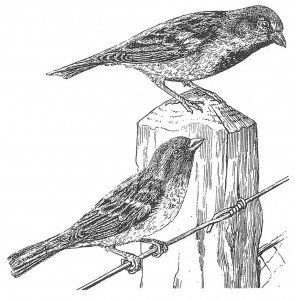Latin: Passer domestica.

Both in terms of food and choice of birthplace the house sparrow is dependent on people. Nests are often placed close together in colonies. When a sparrow has bred somewhere, it will usually stay there for life, which can be 3-4 years.
The house sparrows which are sedentary birds, is at their colony throughout the year and use the nests as roosts in the winter. In March and April they collect material for the nests. The irregular, globular nests are lined with plant fibres, hair, feathers and random material such as paper and plastic.
The sparrows get 2-3 broods during the summer. They feed the young with insects, but the adults live predominantly of waste from households as well as grain and seeds. House sparrows forage on the ground, often in flocks. There are several species of sparrows that – superficially – looks like house sparrows, but they do not build nests on buildings and only occasionally eat grain and seeds.




